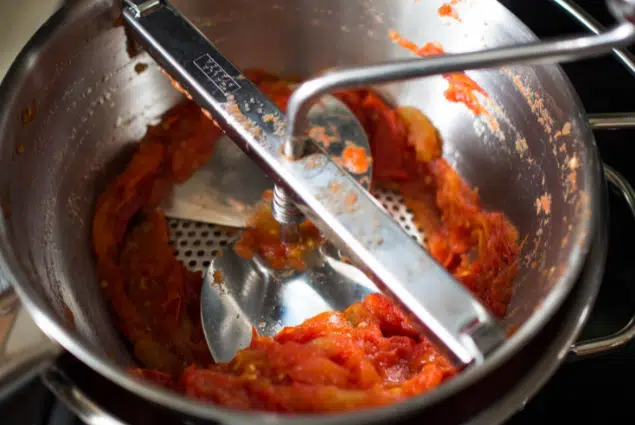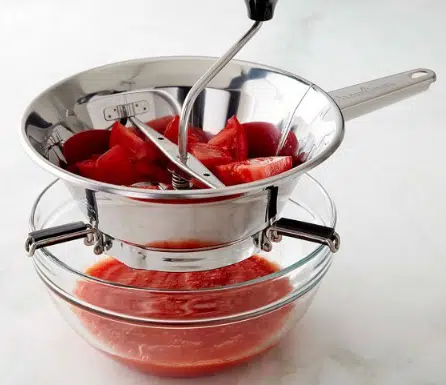Food mills effectively remove the seeds and skins from tomatoes when you want a smooth sauce. How to use a food mill for tomatoes will make your job easier and quicker. Continue reading for a step-by-step guide.
A food mill presses freshly cooked or raw food through a sieve to separate the pulp from the skin, seeds, and stems.
It removes peels and seeds from food items like tomatoes, eggplant, cucumber, carrots, apples, watermelon rinds, and more.
They’re also great for making tomato sauce and puréeing fruit for pie fillings.
It makes homemade applesauce and tomato sauce without the worry of lumps, making it a real timesaver when you’re making a big batch.
Food Mill Uses
 Food mills remove the skin and seeds from fruits and vegetables. It consists of a bowl and handles fitted with a blade used to break down solid food products.
Food mills remove the skin and seeds from fruits and vegetables. It consists of a bowl and handles fitted with a blade used to break down solid food products.
Most food mill consists of a small container with a perforated bottom through which food is forced by turning a crank.
The results from using a food mill are:
- Smooth purées that are ideal for making soups.
- Sauces.
- Baby food and puddings from scratch.
Some models come with a strainer insert specifically for puréeing berries and tomatoes.
It is usually made of stainless steel or plastic. Some models use a clamp to press food against the mill’s blades while turning it by hand, while others rely on gravity to feed food through the blades.
Other uses of food mills are:
It’s a tool used for sauces, broths, jams, purees, and gellies.
It’s excellent for mashing fruits and veggies, including potatoes.
Remember: Overloading a food mill or forcing the pureed food through the food mill’s holes may result in tearing or breaking of the hopper or chain that attaches it to the appliance.
Relayed Post: How Long Can Salami Sit Out
How to use a food mill for tomatoes

Raw Tomatoes
Place the food mill over a medium saucepan for raw tomatoes and press the tomato purée through to strain out seeds and skins.
Pour mixture into a bowl or jar to serve, or transfer to another pan for cooking, depending on your recipe.
You can create fresh purées to serve over pasta, use as a base for soups, or eat right out of the fridge with a spoon.
For dry tomatoes
Put the tomatoes in the food mill and pull the handle across them. If they resist too much, add a little bit of water to help them move through the holes in the bottom of the mill.
Steamed or Boiled Tomatoes
First, peel the tomatoes for sauce for steamed or boiled tomatoes, dip them in boiling water for 10 to 15 seconds or until the skins start to crack.
Plunge them into cold water, then slip off the skins. (Or to peel quickly, dip the tomatoes in boiling water and run under cold water.) Cut out the thick stem end and then slice.
Now press the sliced boiled or steamed tomatoes through a food mill. Put the tomatoes in a large bowl and break them up by hand or with a potato masher. Then pass them through the food mill fitted with the disc with the largest holes.
The resulting sauce will be both smoother and more flavorful to use for your sauce.
Types of Food Mills

1. The classic hand-cranked mechanism.
This type of food mill consists of a metal bowl with a perforated disk and a hand crank that spins metal blades against the disk to force food through tiny holes.
It comprises at least three parts: the hopper, the plunger, and the screw mechanism. The user can place it over a deep bowl and pour the raw product into it to be minced.
The hopper holds the food in place while also serving as a funnel through which it passes through the milling process.
The plunger runs along with the screw mechanism at its center. As long as you turn the handle, they will move in opposite directions, forcing their way through the hopper and pressing down on it at all times.
It features interchangeable disks, allowing you to create different textures for sauces and pastes. Some come with a metal blade that puree ingredients in recipes such as sauces and spreads, while the disk crushes foods such as nuts and dried fruit.
With all these features of this type of food mill, you’re in total control of how smooth the result of whatever you put into it will be.
2. The electric type
An electric food mill is a kitchen device for grinding food. It does not require manual grinding and removing pestles from the bowl but utilizes a powered motor with a dough hook attached to a funnel-shaped or perforated bowl.
The significant difference between a food mill and a food processor is the method of chopping the ingredients. Food mills are suitable for grinding hard ingredients, such as nuts or dried fruits, which would damage or dull the cutting blades of a food processor.
Electric food mills are more quick and easy to use, and they can also double as a juicer for soft foods such as tomatoes, berries, and more.
3. Hand-operated model
The hand-operated model is perfect for making applesauce or pureeing fresh vegetables for soups or baby foods, as well as mashing potatoes with skins on.
This type of mill is a kitchen utensil consisting of a handle attached to a bowl, with a perforated disc at the bottom of the bowl. The discs vary in number and size from one mill to another. The discs are constructed with stainless steel.
Hand operated model is a good choice when the volume of food is not so great and needs to grind in small quantities. It also comes in handy when you only need it occasionally.
It is sturdy and made from materials such as aluminum, stainless steel, and porcelain-enameled cast iron.
The primary purpose of this food mill is to force the food being processed through the small holes, resulting in a purée or very smooth soup.
How to use a Foley food mill for tomatoes

It is also known as a Foley Potato Masher. It features sturdy construction with stainless steel augers, an aluminum bowl with a ribbed bottom, heavy-duty wood handles, and replaceable blades.
To use a Foley food mill for tomatoes:
- Start by washing your fresh tomatoes, removing stems and cores.
- Slice the tomatoes thinly so the pieces can go through the food mill or strainer easily.
- Peel just the very top layer of skin off the tomatoes to prevent getting too much tomato skin in the sauce and avoid losing any flavor.
Gently turn the crank handle as you can. The result will be a smooth tomato sauce with no lumps. Immediately you finish using it, wipe clean with warm soapy water.
Other foley food mill uses
- Foley food mill is a tool for mashing, ricing, and straining cooked foods. Also, it’s a quick way to prepare food and easy to use in making canning, applesauce, mashed potatoes, and baby food.
- It quickly and easily removes seeds and strings from all types of farm produce for a quick, clean, nutritious meal.
- The food mill consists of separate stainless steel filters, all interlocking so you can remove one at a time.
- It hand-presses cottage cheese and sour cream.
- The ones with shredder plates help create fine cuts for delicate recipes.
- The one that uses battery processes foods at low speeds using centrifugal force.
Frequently Asked Question
Can you put raw tomatoes through a food mill?
Put raw tomatoes through a food mill, and the only thing the food mill will catch are seeds and skin, so you’ll have a smooth product without any skin or seeds.
Take fresh tomatoes, have them peeled and pulse them in a food processor until they’re liquefied. Then pass them through a sieve that has been with a wet cleaning rag as this will help keep the rag from being sucked into the mill. You can then use this or adjust the consistency with some water by blending more or less.
Can you use a food mill to make tomato sauce?
You can use a food mill to make tomato sauce. But it depends on the type of food mill you’re using. Simple food mills usually have two discs with holes in them placed close together. They’re used to purée fruits and vegetables.
A tomato sauce, on the other hand, has a chunkier consistency that may require some pre-cooking. If that’s the case, you’ll want to use a food mill meant for fine purees, not the two-disc model.
Will a food mill remove tomato skins and seeds?
A Food Mill removes virtually all seeds and skins from tomatoes, leaving you with a smooth, fresh sauce perfect for canning, freezing, or saving for another day. The spiral type has blades that cut up the skin and press the flesh through gently. These work much better than a two-piece unit.
Do I need a food mill to make tomato paste?
It is not necessary for making tomato sauce, but it will ensure that the sauce is smooth and has a fine texture. It can quickly be done by hand with a strainer, being sure to break up the seeds with your fingers.
Is a food mill the same as a blender?
A food mill is not the same as a blender. A food mill processes soft foods such as fruits and vegetables (skins and seeds included), producing a smoothing consistency while retaining fibrous textures. On the other hand, blenders liquify hard foods such as carrots and potatoes, making a smooth consistency while losing fibrous textures.
Conclusion
Food mills are used for pureeing and straining food. They consist of a bowl or cylinder fitted with a blade or perforated plate over the top of a bowl into which the food to be processed been placed. To get this done perfectly, you need to learn how to use a food mill for tomatoes. It will take your cooking to the next level.

Ingredients
- 5 pounds tomatoes
- ¾ teaspoon salt
- 2 tablespoons olive oil
- 1 tablespoon tomato paste
- 1 garlic clove halved
- 1 basil sprig
- 1 bay leaf
Instructions
- Tomato halves should be cut horizontally. If desired, squeeze the seeds out and toss them. Grate tomato flesh into a bowl by pressing the sliced side of the tomato against the big holes of a box grater. Throw away skins. Four cups should be about right.
- Put tomato pulp over high heat in a low, wide saucepan. Olive oil, tomato paste, garlic, basil, and bay leaf are also to be added. Bring to a boil before reducing the heat to a quick simmer.
- For approximately 212 cups of medium-thick sauce, reduce the sauce by almost half while stirring occasionally, 10 to 15 minutes. salt according to taste. It can be frozen or kept in the fridge for up to 5 days.

